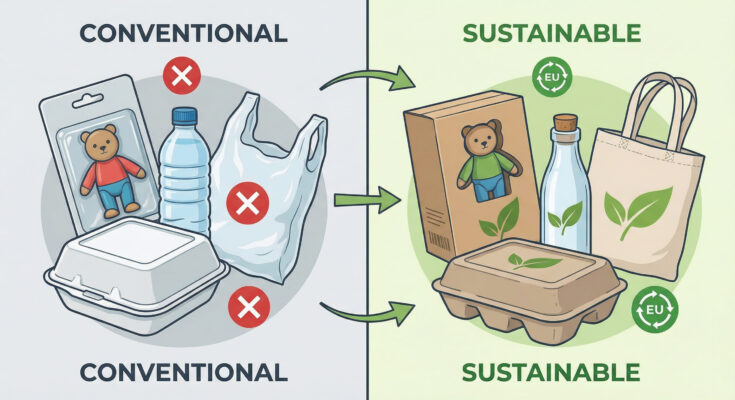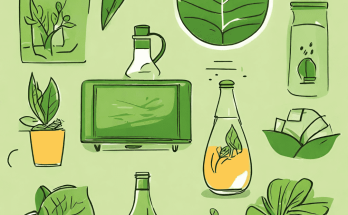The fashion industry is at an inflection point. By July 2025, large European fashion brands must publicly disclose the volume of unsold consumer products they discard annually and their reasons for doing so. This isn’t a recommendation or best practice suggestion. It’s law. The European Union’s updated Packaging and Packaging Waste Regulation (PPWR) is rewriting how fashion companies approach packaging, materials, and waste management.
For businesses in the Netherlands, Germany, France, and across the EU, understanding these regulations isn’t optional. Non-compliance carries substantial penalties and reputational damage. Yet compliance also presents opportunities. Brands leading the sustainable packaging revolution are building stronger customer loyalty, reducing operational costs, and future-proofing their businesses.
The EU’s Ambitious Sustainability Goals
The European Union has positioned itself as a global leader in environmental responsibility. The European Green Deal and Circular Economy Action Plan set clear targets: all packaging must be recyclable or reusable by 2030. Current packaging waste in the EU reaches 84 million tonnes annually, an unsustainable figure the EU is determined to reduce.
The updated PPWR, implemented from July 2024, targets 15% reduction in per capita packaging waste by 2040 compared to 2018 levels. Fashion brands must design packaging that fulfills this mandate. The regulation eliminates unnecessary packaging and restricts certain single-use formats. For the first time, brands face extended producer responsibility, they’re accountable for their packaging throughout its entire lifecycle, from production through recycling.
Key Regulatory Requirements Fashion Brands Must Meet
The PPWR introduces specific obligations that directly impact fashion retailers. First, all packaging must meet recycling requirements. This means moving away from mixed materials that are difficult to sort and recycle. A package combining plastic, paper, and metal creates recycling challenges and often ends up in landfills regardless of its “recyclable” label.
Second, brands must ensure reuse and refill systems are available where practical. Some fashion companies are pioneering takeback programs where customers return packaging for reuse or recycling. Zalando, Europe’s leading online fashion platform, has eliminated plastic shipping bags entirely. XL orders now ship in reinforced paper alternatives, a significant operational shift driven by regulatory requirements.
Third, packaging must include harmonized labeling standards. Consumers need clear information about how to recycle packaging correctly. Confusing or misleading labels contribute to contamination in recycling streams. The PPWR mandates standardized symbols and instructions that work across EU member states.
Fourth, starting July 2025, large enterprises must publicly disclose unsold product disposal information. This transparency requirement forces brands to rethink inventory management. Overproduction and waste are no longer invisible. This regulatory nudge encourages more sophisticated demand forecasting and just-in-time production models.
The Economic Case for Sustainable Packaging
Interestingly, sustainable packaging often reduces costs while improving environmental outcomes. This counter-intuitive reality has converted many skeptics. Consider Zalando’s packaging optimization strategy. By right-sizing boxes, eliminating excess space, the company reduced material use by 20%. This single change cut 919 metric tonnes of plastic annually.
Cost savings emerge through multiple channels. Lighter packaging reduces shipping weight, directly lowering transportation fees. Optimized box dimensions allow more packages to fit in delivery vehicles, reducing overall logistics costs. Simplified designs using fewer materials reduce manufacturing expenses. Zalando’s investments paid for themselves through operational efficiency alone, before considering brand reputation benefits.
Additionally, consumer willingness to pay a premium for sustainable options is rising. Research shows more than 50% of EU shoppers will pay extra for products with sustainable packaging. Brands that demonstrate genuine commitment to sustainability capture this consumer segment. They attract customers willing to pay higher prices, improving profit margins.
Material Innovations Shaping 2025
Fashion brands can’t simply use less of the same materials. The PPWR demands genuine environmental improvements. This has sparked innovation across packaging materials. Bio-based and compostable alternatives are rapidly replacing conventional plastics. Starch blends, cellulose films, and other plant-based materials now offer comparable protection with lower environmental impact.
Zalando exemplifies this shift. The company carefully evaluates each packaging component shipping bags, beauty product packaging, cardboard boxes. FSC-certified paper and recycled content materials now dominate specifications. Recycled fibers do lose some structural strength over time, requiring careful engineering to maintain durability while using recycled content. Success requires balancing environmental goals with practical performance requirements.
Lab-grown alternatives are emerging for certain applications. Lab-grown cotton and synthetic materials grown in bioreactors eliminate water-intensive farming and harmful pesticides. While currently used primarily in textiles, these innovations may extend to packaging applications as production scales.
Crucially, mono-material designs are preferred over complex assemblies. A package made entirely from paper recycles far more effectively than one combining paper, plastic, and metal. Fashion brands are redesigning packaging to use single materials wherever possible. This simplification paradoxically improves performance, simpler designs often protect products better than complex ones.
Challenges and Practical Considerations
Transitioning to compliant sustainable packaging isn’t straightforward. Recycling infrastructure varies significantly across EU markets. What works efficiently in Germany’s advanced recycling system may fail in markets with less developed infrastructure. Brands must consider regional differences when selecting packaging materials.
Cost increases during transition represent another challenge. Sustainable materials often carry premium pricing. Establishing new supply chains, testing materials, and redesigning packaging requires significant upfront investment. Small fashion brands struggle more than giants like Zalando, creating a potential market consolidation pressure.
Consumer confusion remains problematic. Despite improved labeling standards, many shoppers still don’t understand packaging recycling requirements. Some consumers incorrectly believe all “recyclable” packaging will be recycled. Others contaminate recycling streams by including non-recyclable items. Education campaigns are necessary but outside individual brand control.
Supply chain complexity adds another layer. Fashion businesses rely on global suppliers and manufacturers. Coordinating packaging changes across multiple countries, suppliers, and production facilities requires sophisticated logistics. Some manufacturers resist change due to investment requirements or capability limitations.
Success Stories and Best Practices
Zalando’s comprehensive approach provides a useful template. The company committed to systematic material improvements, phasing out plastic shipping bags between 2022 and 2024. They implemented right-sizing logistics that optimally pack boxes for efficient transport. They selected materials with care-balancing strength, sustainability, and cost. They communicated transparently with customers about sustainability improvements.
Smaller brands are finding success through strategic partnerships. Some work with packaging specialists who handle compliance complexities. Others join industry consortiums that collectively negotiate volume discounts on sustainable materials. Collaboration reduces individual burden while improving supply security.
What’s Coming Next
The regulatory landscape will continue tightening. The EU’s focus on “circular packaging” means designing for complete material recovery. Digital product passports are coming, QR codes embedded in packaging that provide lifecycle data facilitating proper recycling. These systems will make packaging material information instantly accessible to consumers.
Brands are preparing for Extended Producer Responsibility (EPR) costs. Under EPR, producers fund waste management infrastructure for their packaging. Costs vary by region and material type but universally incentivize waste reduction. EPR pricing creates financial motivation for minimalist packaging design.
Conclusion
Sustainable packaging isn’t a trend that fashion brands can ignore or outsource. It’s becoming a fundamental business requirement. The EU’s regulatory framework ensures compliance is mandatory across all significant fashion retailers. Companies that view this as burden will struggle. Those recognizing opportunity will lead their industries.
The brands thriving in 2025 and beyond will be those who invest now in sustainable packaging infrastructure. They’ll build reputational advantages, capture price-sensitive consumer segments, and reduce operational costs. They’ll navigate regulatory requirements confidently while competitors scramble for compliance.
For fashion retailers anywhere in the EU, the time for action is now. July 2025 isn’t far away. The best time to implement sustainable packaging was years ago. The second best time is immediately.
Want to learn more about AI? Visit Page Artificial Intelligence




